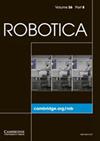Vision-based food handling system for high-resemblance random food items
IF 2.7
4区 计算机科学
Q3 ROBOTICS
引用次数: 0
Abstract
The rise in the number of automated robotic kitchens accelerated the need for advanced food handling system, emphasizing food analysis including ingredient classification pose recognition and assembling strategy. Selecting the optimal piece from a pile of similarly shaped food items is a challenge to automated meal assembling system. To address this, we present a constructive assembling algorithm, introducing a unique approach for food pose detection–Fast Image to Pose Detection (FI2PD), and a closed-loop packing strategy. Powered by a convolutional neural network (CNN) and a pose retrieval model, FI2PD is adept at constructing a 6D pose from only RGB images. The method employs a coarse-to-fine approach, leveraging the CNN to pinpoint object orientation and position, alongside a pose retrieval process for target selection and 6D pose derivation. Our closed-loop packing strategy, aided by the Item Arrangement Verifier, ensures precise arrangement and system robustness. Additionally, we introduce our基于视觉的食品处理系统,用于处理高重现性随机食品
自动化机器人厨房数量的增加加速了对先进食品处理系统的需求,强调食品分析,包括配料分类姿势识别和装配策略。从一堆形状相似的食品中挑选出最佳部件是自动配餐系统面临的一项挑战。为此,我们提出了一种建设性的组装算法,引入了一种独特的食品姿态检测方法--快速图像姿态检测(FI2PD)和一种闭环包装策略。在卷积神经网络(CNN)和姿势检索模型的支持下,FI2PD 擅长从仅有的 RGB 图像中构建 6D 姿势。该方法采用了从粗到细的方法,利用卷积神经网络精确定位物体的方向和位置,同时利用姿态检索过程进行目标选择和 6D 姿态推导。我们的闭环包装策略在 "物品排列验证器 "的辅助下,确保了精确的排列和系统的鲁棒性。此外,我们还介绍了我们的 FdIngred328 数据集,该数据集包含从假冒食品到真实食品的九个食品类别,以及基于合成技术自动生成的数据。结果表明,我们的方法在物体识别和姿势检测方面的成功率高达 97.9%。令人印象深刻的是,将闭环策略整合到我们的膳食组装流程中后,成功率达到了 90%,明显优于缺乏闭环机制的系统。
本文章由计算机程序翻译,如有差异,请以英文原文为准。
求助全文
约1分钟内获得全文
求助全文
来源期刊

Robotica
工程技术-机器人学
CiteScore
4.50
自引率
22.20%
发文量
181
审稿时长
9.9 months
期刊介绍:
Robotica is a forum for the multidisciplinary subject of robotics and encourages developments, applications and research in this important field of automation and robotics with regard to industry, health, education and economic and social aspects of relevance. Coverage includes activities in hostile environments, applications in the service and manufacturing industries, biological robotics, dynamics and kinematics involved in robot design and uses, on-line robots, robot task planning, rehabilitation robotics, sensory perception, software in the widest sense, particularly in respect of programming languages and links with CAD/CAM systems, telerobotics and various other areas. In addition, interest is focused on various Artificial Intelligence topics of theoretical and practical interest.
 求助内容:
求助内容: 应助结果提醒方式:
应助结果提醒方式:


